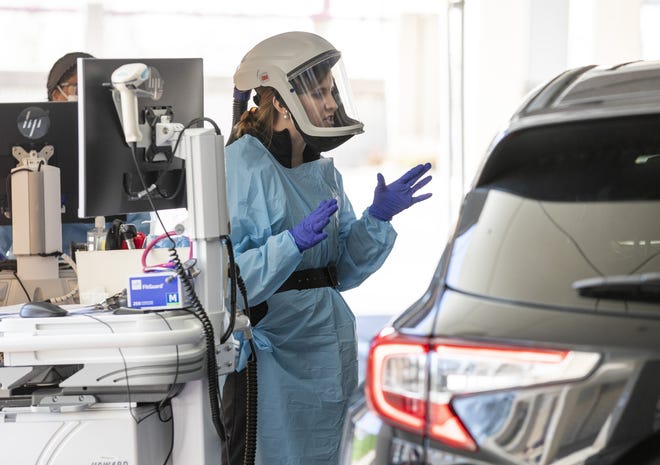
Ohio posted a record 156 daily deaths and 10,835 new coronavirus cases – the second-highest of the pandemic – on Wednesday as its November blitz of infections continued without pause.
The new daily record deaths added to November’s COVID-19 toll as the pandemic’s deadliest month since the record month of May.
Added to the 98 deaths on Tuesday — the second-highest daily total — Wednesday’s 156 deaths brought this month’s total to 973, an increase of 476 nearly double the 497 virus fatalities reported during October.
Health officials also reported 417 new hospitalizations — another daily record — as medical centers continue to fill with patients numbering 4,541 on Wednesday, with nearly a fourth in intensive-care units.
Hospitalizations have more than doubled in the past three weeks.
“These numbers show the threat is real,” said Dan Tierney, spokesman for Gov. Mike DeWine, who is calling on Ohioans to limit Thanksgiving gatherings to household members and reduce their contacts with others to help check the surge.
The positive rate on virus tests increased to 14.2% on the latest reported day (Monday) with the seven-day average at 13.5% — a figure five times higher than late September and the highest since late April.
The only month with more COVID-19 deaths than November — which has five days of deaths still to add — was early in the pandemic: May with 1,180.
MORE: COVID surge: Hospitals have fewer open beds than spring
The most virus deaths previously reported on one day was 138 on April 29. The daily numbers do not represent deaths in the prior 24 hours, but when deaths were reported, which often lags several days, and sometimes weeks, from when deaths occurred.
November’s death total has mounted despite what health officials describe as better and more-advanced virus treatments that are saving critically ill patients who may have died earlier in the pandemic.
The death numbers stem from record-setting numbers of daily virus cases that have regularly reached higher than 7,000 and 8,000 earlier this month and hit nearly 11,000 on Wednesday.
Ohio reported a record 11,885 cases on Monday, but hundreds, if not thousands, of those cases may be attributable to a two-day backlog in adding cases from two medical systems with reporting delays and backed-up confirmation of positive, but less-reliable, antigen tests. Wednesday’s number also is considered incomplete, but could be supplemented with previously delayed data.
Seventy-nine percent of Ohio’s 6,274 virus deaths have occurred among those deemed most vulnerable — those age 70 and over, many with chronic health conditions. At least 3,523 or 56% of all deaths are attributed to nursing home and long-term care residents.
MORE: Ohio planning for mid-December arrival of first vaccine doses
Ohio reported 8,604 new virus cases on Tuesday, the third-most of the pandemic, as the total number of COVID-19 infections this year have doubled in the past five weeks
>>This story is being provided free as a service to our readers during the coronavirus pandemic. You can find more stories on coronavirus here. Please consider supporting local journalism with a subscription.
The state was expected to release its revised county virus map and ratings later on Wednesday. Franklin County last week became the first and only in Ohio to become “purple,” the highest rating signifying severe COVID-19 spread.
Noting Ohio and other states are “red hot” with spikes of cases, DeWine has cracked down on mask wearing in retail stores and imposed an overnight curfew on Ohioans in hope of reducing the spread of the deadly virus.
Believing Halloween gatherings contributed to this month’s high numbers, state health officials fear numbers again could spike in about a week due to indoor Thanksgiving get-togethers of extended families and friends without precautions like masks.
“Thanksgiving could have a much bigger impact and result in our hospitals being overwhelmed,” said Dr. Bruce Vanderhoff, chief medical officer for the Ohio Department of Health.
“Anytime you have one single diagnosis that’s occupying 20 to 30% of the beds in your hospital … that is unheard of,” Vanderhoff said.
rludlow@dispatch.com
@RandyLudlow